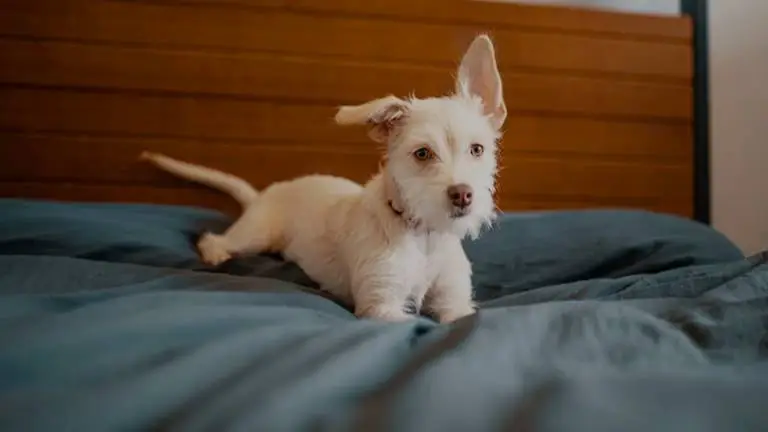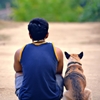Dogs can’t talk, but they sure do communicate. One of the most captivating ways they express themselves is through the subtle glances known as “dog side eye.”. Whether it’s a fleeting glance or a stare that seems to last forever, your pup’s gaze can give you an inside look into what they’re thinking and feeling.
When a dog gives you the side eye, it could mean one of a few different things. It could be a sign of mistrust if your pup is unfamiliar with something, or even with someone. It might also be an indication that your pup is feeling unsure or uncomfortable in their current situation.
In other cases, however, the side eye can be a sign of playfulness. If your pup is looking at you with wide, rounded eyes while their ears and tail are perked up, they’re likely feeling excited and inviting you to join in the fun!
What is Dog Side Eye?
Discovering the fascinating meaning behind a dog’s side eye behavior is an intriguing endeavor. Dogs exhibit this behavior by swiftly turning their heads and directing a sideways glance while maintaining visual contact.
By delving into the reasons behind why dogs give side eye and exploring the triggers for this behavior, we can gain a deeper understanding of its significance. Research suggests that dogs possess brain structures akin to humans, aiding in their emotional processing and facial recognition abilities.
By comprehending the scientific aspects underlying their expressions, we can uncover the connection between dogs’ side eye and their emotions. To interpret a dog’s side eye, careful observation of their environment and context is paramount.
Dogs are acutely attuned to their surroundings, thus their expressions are influenced by various factors such as the presence of unfamiliar individuals or other dogs. By considering these elements, we can decipher the intended messages our canine companions are attempting to convey. In addition to context, it is essential to pay attention to accompanying facial expressions.
Dogs employ subtle movements like raised eyebrows, flattened ears, or tense mouths to further express their emotions. By attentively observing these cues, we can unravel the genuine meaning behind a dog’s side eye, unraveling the intricate language of their unspoken communication.
What is Whale Eye in Dogs?
While the Dog side eye is a common expression that a dog uses, there’s another that you might not be as familiar with: Whale Eye. This term refers to when a dog rolls their eyes back in an exaggerated manner, giving the appearance of a “whale eye.” This expression can be seen when your pup is feeling threatened, stressed or overwhelmed by something or someone.
For example, if you approach your dog while they’re eating and they give you the whale eye, it’s likely they’re feeling a bit uncomfortable and would like you to back off. On the other hand, if you’re playing fetch with your pup and they start to give you the whale eye, it might be because they’re getting a bit overwhelmed by the activity and need some time to relax.
Signs of Dog Side Eye
A noteworthy distinction exists between a dog’s sideward glance and an ordinary look. Simply because your pup stares at you from the corner doesn’t necessarily imply anything. If your pup hears a sound as you pass, they could quickly glance aside. In this situation, they’re casually observing you while you stroll by.
Annoyed dogs will not only have a “whale eye,” but their body will appear strained, and your pup may fold their ears back. Your dog may give you this look as if they’re shielding something or simply desire to be left alone.
What To Do When Dog Gives Side Eye
If you spot dog side eye , there’s no need to be alarmed. Everybody needs a break from others sometimes. Your pup is not attempting to intimidate you, but instead might just need some alone time. If you catch your pup giving you the side-eye, it’s best to give them some space.
Avoid approaching your dog if they are shielding something that’s important to them, like their toys or food. It could be a good idea to exit the room and come back once your dog has finished with their meal or stopped playing with their toy.
Once it’s evident that your dog is done with the object they were protecting, you can take it away. It’s best to take away any critical objects with caution. Shortly after, they’ll likely be back to giving you those adorable puppy eyes.
Can all Dogs give Side Eye?
Yes, all dogs have the ability to give side-eye. Dog Side Eye is a natural behavior exhibited by dogs, and it is a part of their communication repertoire. However, it’s important to note that not all dogs may exhibit side eye in the same way or to the same extent.
Each dog has its own unique personality and way of expressing emotions, including through their gaze. Some dogs may show sideeye more frequently or prominently, while others may not exhibit it as prominently or may have different ways of expressing their emotions. It’s essential to understand and interpret a dog’s overall body language and context to get a complete understanding of their communication signals.
Final Thoughts
The Dog Side Eye behavior is a captivating form of communication that provides insights into their thoughts and emotions. It can indicate mistrust, uncertainty, discomfort, or playful invitation depending on the context and accompanying body language.
Recognizing the distinction between side eye and the more intense “whale eye” expression helps us respond appropriately to their needs. Respecting their personal space and boundaries when they give side eye is essential.
While all dogs have the ability to give side eye, the frequency and intensity may vary. Understanding their overall body language and accompanying facial expressions enhances our ability to interpret their messages accurately. By delving into the intriguing world of dog side eye, we can deepen our connection and ensure their well-being.
(The blog post has been updated on 26 May 2023, with more helpful information)


